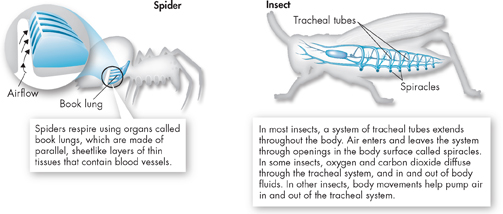
FIGURE 27–7 Respiratory Structures of Terrestrial Invertebrates Terrestrial invertebrates have a wide variety of respiratory structures, including skin, mantle cavities, book lungs, and tracheal tubes. These structures must stay moist even in the driest of conditions in order to function properly.
ddRespiratory Surfaces of Terrestrial Animals
 What respiratory structures enable land animals to breathe?
What respiratory structures enable land animals to breathe?
Terrestrial animals, as you might have guessed, face a challenge that aquatic animals don't. Terrestrial animals must keep their respiratory membranes moist in dry environments.
Respiratory Surfaces in Land Invertebrates The wide range of body plans among terrestrial invertebrates reveals very different strategies for respiration.  Respiratory structures in terrestrial invertebrates include skin, mantle cavities, book lungs, and tracheal tubes. Some land invertebrates, such as earthworms, that live in moist environments can respire across their skin, as long as it stays moist. In other invertebrates, such as land snails, respiration is accomplished by the mantle cavity, which is lined with moist tissue and blood vessels. Insects and spiders have more complex respiratory systems, as you can see in Figure 27–7.
Respiratory structures in terrestrial invertebrates include skin, mantle cavities, book lungs, and tracheal tubes. Some land invertebrates, such as earthworms, that live in moist environments can respire across their skin, as long as it stays moist. In other invertebrates, such as land snails, respiration is accomplished by the mantle cavity, which is lined with moist tissue and blood vessels. Insects and spiders have more complex respiratory systems, as you can see in Figure 27–7.
Lung Structure in Vertebrates Terrestrial vertebrates display a wide range of breathing adaptations.  But all terrestrial vertebrates—reptiles, birds, mammals, and the land stages of most amphibians—breathe with lungs. Although lung structure in these animals varies, the processes of inhaling and exhaling are similar. Inhaling brings oxygen-rich air through the trachea (TRAY kee uh), or airway, into the lungs. Inside the lungs, oxygen diffuses into the blood through lung capillaries. At the same time, carbon dioxide diffuses out of capillaries into the lungs. Oxygen-poor air is then exhaled.
But all terrestrial vertebrates—reptiles, birds, mammals, and the land stages of most amphibians—breathe with lungs. Although lung structure in these animals varies, the processes of inhaling and exhaling are similar. Inhaling brings oxygen-rich air through the trachea (TRAY kee uh), or airway, into the lungs. Inside the lungs, oxygen diffuses into the blood through lung capillaries. At the same time, carbon dioxide diffuses out of capillaries into the lungs. Oxygen-poor air is then exhaled.
 In Your Notebook Would you expect dolphins to breathe with gills or lungs? Explain your answer.
In Your Notebook Would you expect dolphins to breathe with gills or lungs? Explain your answer.
BUILD Vocabulary
MULTIPLE MEANINGS The biological term respiration has different, though related, meanings. In animals, it can refer to gas exchange, the intake of oxygen and release of waste gases, or to cellular respiration, the cell process that releases energy by breaking down food molecules in the presence of oxygen. Because cellular respiration requires oxygen, the two processes are related.

Table of Contents
- Formulas and Equations
- Applying Formulas and Equations
- Mean, Median, and Mode
- Estimation
- Using Measurements in Calculations
- Effects of Measurement Errors
- Accuracy
- Precision
- Comparing Accuracy and Precision
- Significant Figures
- Calculating With Significant Figures
- Scientific Notation
- Calculating With Scientific Notation
- Dimensional Analysis
- Applying Dimensional Analysis




